Urban rail in the United Kingdom
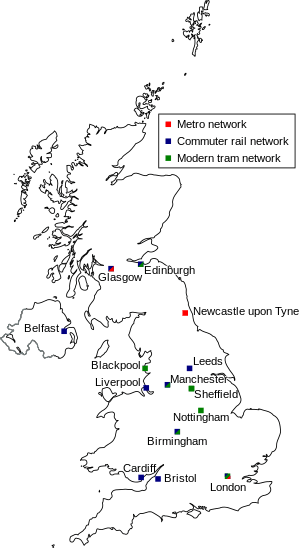
Urban rail, commuter rail, regional rail, or suburban rail plays a key role in public transport in many of the United Kingdom's major cities. Urban rail is defined as a rail service between a central business district and suburbs or other locations that draw large numbers of people on a daily basis. The trains providing such services may be termed commuter trains.[1]
Unlike light rail, urban rail is classed as heavy rail, operating on lines shared with other passenger and freight trains with networks often larger than those of light rail. The infrastructure in Great Britain is owned by Network Rail,[2] and stations served by one urban rail network may be managed by different train companies. In Northern Ireland NI Railways have responsibility for both the infrastructure and operations.
Advantages over light rail

As urban rail networks are part of the wider rail network, there is often easy interchange with mainline rail, rail cards being accepted. Cycles can be taken on board in the majority of cases, and existing railways can be used, rather than new light railways being built.
Unlike most light rail systems, only one ticket needs to be bought if a journey includes both mainline and urban rail. Urban rail usually has higher capacity than light rail because of longer trains (but often lower frequency), and higher average speed because of fewer stops.
Services
A few urban railways offer service during peak times only, and others operate less frequent trains during the evenings and on Sundays.
Networks often encompass a few major stations in a large city, with other stations being medium or minor. Services can be provided by one train operating company operating exclusively on an urban rail network, such as in Merseyside, or by a company that also operates regional and national services, like in Bristol, Cardiff, Edinburgh and Glasgow.
Cities
Belfast

In Northern Ireland's capital, Northern Ireland Railways Belfast Suburban Rail serves Greater Belfast. Services run about every 20 minutes from 06:00 until 24:00 on:
- Larne Line: Belfast Great Victoria Street - Belfast Central - Larne Harbour
- Portadown Line: Belfast Central - Portadown - Newry
- Bangor Line: Belfast Great Victoria Street - Belfast Central - Sydenham - Bangor
Some services run between Larne and Portadown, calling at all stations. Belfast Suburban Rail serves 39 different stations on three lines.
Birmingham

Co-ordinated and subsidised by Transport for West Midlands (TfWM), (formerly known as Centro) London Midland operates a network of 63 stations[6] in the West Midlands county focused on Birmingham. London Midland operate the West Midlands commuter routes as London Midland City to distinguish them from their longer-distance routes. The main city-centre station is Birmingham New Street, operated by Network Rail, the other city-centre stations are Birmingham Snow Hill and Birmingham Moor Street. The other main stations in the West Midlands are Wolverhampton and Coventry.
During 2014/15, there were nearly 51 million rail passenger journeys in the TfWM area.[7] Birmingham has the highest proportion of rail commuters in England outside London.[8] In the past few decades the proportion of journeys into central Birmingham by rail has grown sharply: 29% of journeys into Birmingham city centre in the peak hours were made by rail in 2015,[7] compared to 17% in 2001, 12% in 1991.[9][10]
Most of the Birmingham and West Midlands County local commuter lines are centred on New Street station, including the Cross-City Line, the Chase Line and the Coventry-Wolverhampton Line. Three commuter routes, known collectively as the Snow Hill Lines run through Snow Hill and Moor Street stations. Services run at ten-minute frequencies on the busiest routes, with most other routes operating at least a 15-20 or 30 minute frequency. Services are run as below:
- Birmingham Loop - Wolverhampton - Birmingham New Street - Birmingham International - Coventry.
- Cross-City Line - Lichfield Trent Valley – Birmingham New Street – Longbridge – Redditch.
- Chase Line - Birmingham New Street - Walsall - Rugeley Trent Valley.
- Snow Hill Lines - Worcester – Kidderminster – Stourbridge – Birmingham Snow Hill – Birmingham Moor Street – Solihull – Dorridge – Leamington Spa / Whitlocks End – Stratford upon Avon.
Lines to Wolverhampton and Coventry operate from outside the TfWM-supported area, most notably on the Wolverhampton to Shrewsbury Line and the Coventry to Nuneaton Line.
Plans are being pursued to restore local passenger services to the Camp Hill Line in southern Birmingham, which is currently freight only, by constructing new chords into Birmingham Moor Street station. This would also allow for new local services from Moor Street on the lines from Birmingham to Tamworth and Nuneaton. Restoration of local passenger services to the freight only Walsall to Wolverhampton Line, is also being pursued.[11][12]
Centro was created in 1969 following the Transport Act 1968. The Transport Act 1985 deregulated and privatised bus services across the UK. WMPTE co-ordinated the services of all local private bus operators and adopted the name of Centro shortly afterwards to distinguish itself from its previous role as an operator.[13] In 2016 Centro was abolished and replaced with Transport for West Midlands.
Bristol


There are 13 suburban and two main-line stations (Bristol Temple Meads and Bristol Parkway) in Bristol, all operated by First Great Western. The only commuter line is the 13.5 mile long Severn Beach Line with 11 stations and 374,000 journeys in 2005/6. The operator estimates that 57% of travellers on the line commute, rather than for leisure.[14] running every half an hour to Avonmouth and continuing every hour to Severn Beach.[15] A further two commuter lines from Bristol Temple Meads to Portishead and Henbury are due to open in 2019[16] and 2021[17] respectively. Services also run from Gloucester - Westbury and Cardiff Central - Taunton via Bristol.
Other suburban stations lie on main lines, South Wales Main Line (Bristol – Cardiff via Newport), Great Western Main Line (Bristol – London via Bath, Chippenham, Swindon and Reading) and Wessex Main Line (Bristol – Southampton via Bath and Salisbury).
Commuter services operate to and from nearby Bath.[18]
Cardiff


The Valley Lines network of eight lines (Cardiff Bay Line, City Line, Coryton Line, Maesteg Line, Merthyr Line, Rhondda Line, Rhymney Line and Vale of Glamorgan Line) incorporates 20 stations in Cardiff, the capital of Wales, and 61 in surrounding towns and villages. Its hubs are Cardiff Queen Street and Cardiff Central. Train frequencies are up to every five minutes.[19] The Ebbw Valley Railway also draws commuters to the capital.
Arriva Trains Wales operates the stations and services. In February 2008, the Ebbw Valley Railway re-opened after 45 years with an hourly service to Cardiff Central.[20] Until the line's closure in 1962, passengers had had to change at Newport.
The Maesteg line is incorporated into the wider network: trains continue to Cheltenham Spa from Cardiff Central. The Vale of Glamorgan Line serves Cardiff International Airport.
However, the network neglects large residential areas in the south-west and east of Cardiff,[21] although the South Wales Main Line runs through these areas without any stations.
Between 1995 and 2001, the network (except the Maesteg Line) was operated by Valley Lines, the trading name of the Cardiff Railway Company. It then became part of the Wales & Borders franchise before becoming part of the Arriva Trains Wales franchise.
Edinburgh
Abellio ScotRail operates four commuter lines (with 40 stations) in and around the Scottish capital: the Edinburgh to Bathgate Line, the Borders Railway, the Edinburgh to Dunblane Line and the Fife Circle Line. Edinburgh Waverley and Haymarket are the city's two major stations with connections to mainline services.
A project to open a rail link to Edinburgh Airport was cancelled in September 2007 by the Scottish Government in favour of construction of a station at nearby Gogar, which will connect with the Edinburgh tram network to take passengers to the terminal.[22] A proposal to re-open the Edinburgh suburban railway line has been made by campaigning groups.[23]
Glasgow

Glasgow is Scotland's biggest city and has the UK's largest suburban rail network outside London. Much of the network is electrified, with some lines operated by diesel trains. Trains are operated by Abellio ScotRail; Transport Scotland oversees the management of routes, fares and timetables for all train services in Scotland - until 2005, train services around Glasgow were managed by Strathclyde Passenger Transport. Because of this historic split there are differences between train services in Strathclyde and the rest of Scotland. There is no First class travel in Strathclyde, and morning peak time finishes at 09:00 (rather than 09:15) with no evening peak time.
Glasgow Central and Glasgow Queen Street are the two mainline train stations, both in the city centre. Services to the south leave from Central, and to the north leave from Queen Street. Two lines run underground east to west through the city centre: the North Clyde line through Queen Street and the Argyle Line through Central, from underground platforms below the mainline stations. The North Clyde and Argyle lines meet at Partick, which is also served by the Glasgow Subway. There are Subway stations near Central (St Enoch) and Queen Street (Buchanan Street).
A bus services to Glasgow International Airport operates from Paisley Gilmour Street station. Glasgow Prestwick Airport has its own railway station on the Ayrshire Coast line, and is the only airport in Scotland with its own station. A direct rail link from Glasgow Central to Glasgow International Airport was planned, but was cancelled in 2009.
Liverpool
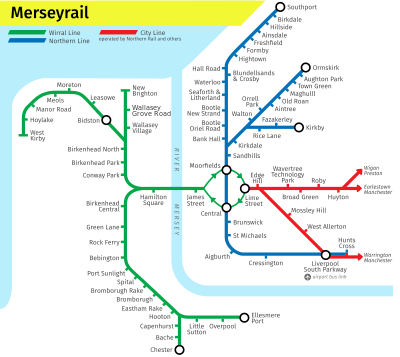
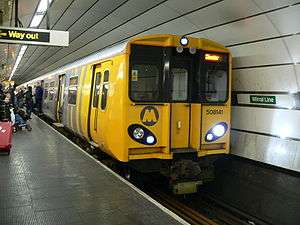
The partially underground Merseyrail network consists of three lines, the Northern Line, Wirral Line and City Line, which interconnect in Liverpool's city centre. The Northern and Wirral Lines run in tunnels in the centres of Liverpool and Birkenhead. Liverpool is the nucleus of the network, which sees 100,000 people a day travel through 67 stations on the electrified lines.[24] The origins of the network are old dating back to the 1886 Mersey Railway, which was the world's second oldest underground railway.
The 75 mile long electric third rail Northern and Wirral Lines are 100% dedicated Merseyrail lines operating separately from the City Line. The City Line currently uses diesel trains operated by Northern. The local passenger transport executive, Merseytravel, brands all commuter rail lines running through Merseyside as Merseyrail with stations inside Merseyside branded as Merseyrail stations. The City Line will be fully electrified by the end of 2014.
The Northern and Wirral lines operate under the train operating company called Merseyrail. Commuter trains run on both the electrified lines.[25] The service operates at metro frequencies in central Liverpool and Birkenhead.
The City Line is operated by Northern running into Merseyside from outside the region, receiving funding from Merseytravel. The City Line consists of non-electrified lines heading east and one electrified running south. Liverpool Lime Street is the terminus of the City Line, with a connection to the Wirral Line at Lime Street underground station. There is also a connection with the Northern Line at Liverpool South Parkway in the south of Liverpool. The City Line is to be electrified to the Wigan and Manchester branches.[26]
The network includes the following lines:
- City Line: Liverpool Lime Street – Huyton – Wigan North Western
or Liverpool Lime Street – Liverpool South Parkway – Manchester Oxford Road
or Liverpool Lime Street – St Helens Junction – Manchester Victoria
or Liverpool Lime Street – St Helens Junction – Manchester Piccadilly – Manchester Airport
or Liverpool Lime Street – Huyton – St Helens Central – Preston – Blackpool North - Wirral Line: Liverpool Lime Street – Liverpool Central – Birkenhead – West Kirby or New Brighton or Ellesmere Port or Chester
- Northern Line: Hunts Cross – Liverpool South Parkway – Liverpool Central – Kirkby or Ormskirk
or Hunts Cross – Liverpool South Parkway – Liverpool Central – Bootle – Southport
Leeds
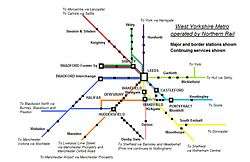

The West Yorkshire Metro oversees Northern commuter trains on 11 lines connecting urban centres such as Leeds, Bradford, Wakefield and Huddersfield and small commuter towns and villages in the Leeds city region, branded as Metro.[27]
The network incorporates the following lines, which often continue to longer distance destinations:
- Airedale Line: Leeds/Bradford - Skipton - Lancaster - Morecambe or Settle - Carlisle
- Caldervale Line: Leeds - Bradford - Halifax - Manchester Victoria or Blackpool
- Hallam Line: Leeds - Castleford - Wakefield Kirkgate - Barnsley - Sheffield
- Harrogate Line: Leeds - Harrogate - Knaresborough - York
- Huddersfield Line: Leeds or Wakefield - Huddersfield - Manchester Piccadilly - Manchester Airport or Liverpool
- Leeds-Bradford Line: Leeds - Bradford Forster Square or Interchange (not a separate line, but a composite timetable of all Leeds to Bradford services on the Airedale and Calderdale Lines.)
- Penistone Line: Huddersfield - Barnsley - Sheffield
- Pontefract Line: Leeds or Wakefield - Pontefract - Goole
- Wakefield Line: Leeds - Wakefield - Doncaster - Sheffield
- Wharfedale Line: Leeds or Bradford - Ilkley
- York & Selby Lines: Leeds - Selby - York - Hull - Scarborough - Middlesbrough - Newcastle upon Tyne
Manchester


Commuting via rail by wealthy merchants living in North Cheshire and South Lancashire into the centre of Manchester was a fairly early phenomenon thanks to the opening of railways such as the Liverpool and Manchester Railway, Sheffield, Ashton-under-Lyne and Manchester Railway, Manchester, South Junction and Altrincham Railway & Manchester, Sheffield and Lincolnshire Railway, in the 1830s & 1840s.[28] All had stations in what were then the outskirts of Manchester, from where citizens could take a train into the centre of the city. Sale, Alderley Edge and Wilmslow are examples of early settlements that had railway stations in the early-mid-19th century and grew into sizable commuter towns.
Urban rail services to Manchester nowadays forms part of the Northern network.
Around 25 million journeys are made on the Greater Manchester local rail network, compared to 34 million Metrolink tram journeys. Buses make up a far bigger number than both however with 225 million journeys per year.[29][30]
The biggest point of entry to the city is Manchester Piccadilly which accommodates 13 lines [31] on which services are provided up to around every 15 minutes.[32]
These include lines to/from Bolton, New Mills Central, Crewe, Liverpool Lime Street, Chester, Warrington Central, Hadfield / Glossop, Huddersfield and Southport.[31]
There are also 11 routes from Manchester Victoria, all operated by Northern Rail.
Routes are as follows:
- Buxton Line: Manchester Piccadilly - Stockport - Hazel Grove - Buxton
- Calder Valley Line: Manchester Victoria - Rochdale - Blackburn / Leeds
- Crewe to Manchester Line: Manchester Piccadilly - Stockport / Manchester Airport - Wilmslow - Crewe
- Glossop Line: Manchester Piccadilly - Guide Bridge - Glossop - Hadfield
- Hope Valley Line: Manchester Piccadilly - Guide Bridge - Romiley - Rose Hill Marple / Marple / Stockport - Hazel Grove - Chinley - Sheffield
- Huddersfield Line: Manchester Victoria - Ashton-under-Lyne - Stalybridge - Huddersfield
- Manchester-Liverpool Lines: Manchester Piccadilly - Warrington Central - Liverpool South Parkway - Liverpool Lime Street / Manchester Victoria - Earlestown - Liverpool Lime Street
- Manchester to Preston Line: Manchester Piccadilly & Victoria - Salford Crescent - Bolton - Preston
- Manchester to Southport Line: Manchester Piccadilly & Victoria - Salford Crescent - Wigan Wallgate - Southport
- Mid-Cheshire Line: Manchester Piccadilly - Stockport - Altrincham - Chester
- Ribble Valley Line: Manchester Victoria - Bolton - Darwen - Blackburn - Clitheroe
91 stations are within the Greater Manchester ticketing zone. There are links to the Metrolink tram network at Manchester Piccadilly, Manchester Victoria, Manchester Deansgate, Altrincham, Navigation Road, Eccles (400m walk), Rochdale, Ashton-under-Lyne (from 2013), East Didsbury (200m walk) and Manchester Airport. Tickets bought for rail travel within Greater Manchester ticketing zone to the four city-centre stations (Deansgate, Oxford Road, Victoria and Piccadilly) are to "Manchester Central Zone", rendered on the ticket as "MANCHESTER CTLZ", and allow free tram travel within the Metrolink tram city fare zone (eight stops within the Piccadilly-Victoria-Deansgate station triangle).
Transport for Greater Manchester co-ordinates rail services within Greater Manchester. It was created in 1969 as the SELNEC PTE (South East Lancashire North East Cheshire) following the Transport Act 1968, and was renamed GMPTE in 1974 before becoming TfGM in 2011.
Greater London
Stations in London (apart from Heathrow Central) are within Travelcard zones. Some stations outside Greater London, for example Chigwell in Essex, are within zones 4-6; many stations outside London are within zones 6-9, for example Amersham and Shenfield, but some stations much closer to the Greater London boundary, like Esher and Staines, are not in any zone. London has integrated ticketing system via the Travelcard or Oyster Card for buses, Docklands Light Railway, suburban rail, tram and Underground and Overground.
Unlike cities like Liverpool/Merseyside, Sydney and Paris, several operators provide suburban rail services. Most stations are served at least every 20 minutes, with many stations and routes having four, six or more trains per hour.
c2c
c2c runs from London Fenchurch Street through east London via Basildon (or Grays and Tilbury) to Southend Central and Shoeburyness, serving eight stations in Greater London.
Chiltern Railways

Chiltern Railways serves eight stations within London from Marylebone, with up to two trains per hour. Sudbury & Harrow Road, London's least used station, has no services outside peak hours or on weekends.
There is a proposal for a Chiltern Metro Service between Marylebone and West Ruislip, operating at 4+ trains per hour, stopping at Wembley Stadium, Sudbury & Harrow Road, Sudbury Hill Harrow, Northolt Park, South Ruislip and West Ruislip. This would require a reversing facility at West Ruislip, passing loops at Sudbury Hill Harrow and Wembley Stadium (part of the old down fast line is in use as a central reversing siding for stock movements and eight-car shuttles for stadium events).[33]
Thameslink and Great Northern
The Thameslink and Great Northern network extends from Brighton to Bedford and from central London to Norfolk. Thameslink and Great Northern run two distinct services, Great Northern and Thameslink. The Great Northern route runs from King's Cross and Moorgate. Suburban services serve stations such as Alexandra Palace, Enfield Chase and Oakleigh Park. Stations within London have three or six trains per hour, but stations on the Northern City branch were not served on weekends until December 2015.
The Thameslink route is undergoing a major upgrade due for completion in 2018. Trains run from Bedford to Brighton and from Luton to Sutton. The network links Luton Airport, St Pancras International (for Eurostar services) and Gatwick Airport and London Blackfriars, London Bridge and Wimbledon. Stations in the north London and some South London suburbs are served every 15 minutes, while stations in Central London are served every 15 minutes for each service. Stations on the Wimbledon Loop Line are served every 30 minutes.
Abellio Greater Anglia

Abellio Greater Anglia operates frequent services from Southend Victoria, Ipswich, Clacton-on-Sea and Braintree to Liverpool Street station throughout the day along the Great Eastern Main Line, as well as from Southminster, Walton-on-the-Naze and Harwich Town during the peak hours.
On the West Anglia and Lea Valley lines, four trains per hour go to Chingford and four via Edmonton Green, with two continuing to Enfield Town or Cheshunt. Semi-fast services run from Liverpool Street to Hertford East via Tottenham Hale and from Stratford via Tottenham Hale to Bishops Stortford. The Stansted Express links London to London Stansted Airport and calls at Tottenham Hale. Angel Road is a limited-service station.
Heathrow Connect and Great Western Railway

Great Western Railway operates from Paddington to Greenford, Slough, Reading and Oxford stopping at west London suburbs including Ealing, Southall and Hayes. It also operates Heathrow Connect jointly with Heathrow Airport Holdings, with services from Paddington and calling at all stations between Ealing Broadway and Heathrow Terminal 4. Great Western Railway also operate services to South Wales and Western England. Stations within London are served by two or four trains per hour.
London Overground
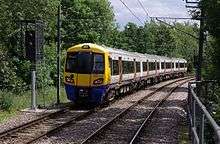
The London Overground (often shortened to Overground) is operated by London Overground Rail Operations under a concession let by Transport for London, which owns the London Underground. The Overground includes the Watford Local, North & West London, East London & South and the Gospel Oak to Barking lines. It is the only National Rail service shown on the London Underground map.[34] All stations are served at least every 20 minutes, with stations on between Dalston Junction and Surrey Quays on the East London Line having 16 trains per hour in each direction.
On the West Anglia and Lea Valley lines, four trains per hour go to Chingford and four via Edmonton Green, with two continuing to Enfield Town or Cheshunt.
Southeastern

Southeastern operate over a large network in south-east London, with services reaching Kent and parts of East Sussex, covering 741 km (460 mi) of railway. Its London termini are Charing Cross, Victoria, Blackfriars, Cannon Street, London Bridge and St Pancras International. Southeastern provides most of its stations with a frequency of 4-6 trains per hour. Stations on the Bromley North Line are served every 20 minutes and stations on the Catford Loop Line every 30 minutes.
Southern
Southern provides services in South London and between Central London and the South Coast, through East and West Sussex and Surrey, and parts of Kent and Hampshire.[35] Southern manages 167 stations and operates up to every 15 minutes on 14 lines south from London Victoria via Clapham Junction and 10 from London Bridge. All but five Southern stations in the London Travelcard zones are served at least every 20 minutes.
South West Trains

South West Trains (SWT) operate out of Waterloo via Clapham Junction, with 160 million passenger journeys on the wider network each year.[36] The SWT network is the busiest in the UK, serving the busiest railway station in terms of passenger numbers (Waterloo) and in terms of trains per hour (Clapham Junction). All SWT stations apart from Fulwell, Hampton, Berrylands, Thames Ditton, Hampton Court, Strawberry Hill and those on the Chessington Branch are served by at least four trains per hour. The residential station of Earlsfield is served by 16 trains per hour, while Vauxhall is served by 26 trains per hour.
SWT also operates longer distance services as far as Weymouth, Portsmouth, Bristol and Exeter.[37]
Crossrail
Crossrail is a project to connect the Great Western Main Line with the Great Eastern Main Line via tunnels across central London with a branch to Abbey Wood. It is the largest construction project in Europe. Crossrail will start a full service in 2018, taking over suburban services operated by Abellio Greater Anglia to Shenfield, Heathrow Connect to Heathrow Airport and First Great Western to Reading.
Once opened, Crossrail will be one of four partially underground suburban rail networks in the United Kingdom as the network cannot be classed as a Metro system like the London Underground or the Glasgow Subway. The Merseyrail and Glasgow commuter rail networks also have below ground stations. Exactly 25% of Crossrail's 40 stations will be below ground.
Crossrail 2 is a prospective line running north-east to south-west through London.
Exeter
Despite being a relatively small city, Exeter is served by three commuter lines. Nine railway stations are within its boundaries (seven of them being suburban), which means the city is served exceptionally well by rail for a city of its size. The main hub for the network is Exeter St Davids railway station which has six platforms and cross country services to places as far as Edinburgh.
The Avocet Line runs from Exeter St Davids to Exmouth, a medium-sized commuter town and seaside resort, via Topsham, Exton and Lympstone.
The Riviera Line runs from Exeter St Davids to Paignton via Teignmouth, Newton Abbot and Torquay.
The Tarka Line is the only railway line that goes to north devon and runs from Exeter St Davids to Barnstaple via Crediton.
The only railway station in Exeter which is not on any of the commuter lines is Pinhoe railway station, on the city's northeastern outskirts, however it is on the South West Trains mainline route to London Waterloo.
Plymouth
The city of Plymouth is home to the smallest commuter rail network in the United Kingdom with one line, the Tamar Valley Line. This line has nine stations and terminates at Gunnislake railway station in the neighbouring county of Cornwall. Five of the stations are within the boundaries of Plymouth while an extra two are within the West Devon district and another two are in Cornwall. The only railway station in Plymouth which is not served by this line is St Budeaux Ferry Road railway station which is on the Cornish main line in the northwestern suburb of St Budeaux.
Newcastle Upon Tyne
As well as the Tyne and Wear Metro, Wearside and Tyneside are linked by fast Northern Rail trains.[38] The whole network is made up of two lines, the Durham Coast Line and the Tyne Valley Line which link Newcastle with Carlisle, Hexham, Sunderland and Middlesbrough with 25 stations overall. These services are funded by Nexus and is one of four transport systems serving Tyne and Wear, with the others being the Metro, the Shields Ferry and the large bus network which serves the county and surrounding communities.[39]
Largest Commuter Rail Networks
This is a list for the largest commuter rail networks in the United Kingdom outside London. London's commuter rail network has several operators and over 500 stations on many different lines.
| Name of City | Number of Lines | Number of Stations |
|---|---|---|
| Glasgow | 13 | 178 |
| Manchester | 11 | 91 |
| Cardiff | 8 | 81 |
| Liverpool | 3 | 67 |
| Birmingham | 6 | 60 |
| Edinburgh | 4 | 40 |
| Belfast | 3 | 39 |
| Exeter | 3 | 32 |
| Newcastle upon Tyne | 2 | 25 |
| Bristol | 1 | 11 |
| Plymouth | 1 | 9 |
Glasgow is the largest and most extensive commuter rail network in the United Kingdom outside London. The city is also unique in being the only city in the UK that has a fully underground metro system, the Glasgow Subway, as the London Underground is only 46% underground.
See also
- Cercanías - Commuter rail in Spain
- S-Bahn - Commuter rail in Germany
- Elektrichka - Commuter rail in Russia
- Commuting
- Public transport
- List of suburban and commuter rail systems
- Rail transport in Great Britain
References
- ↑ http://www.123exp-trains.com/t/18664055193/,commuter%20rail,Regional%20rail
- ↑ "We own and operate Britain's rail infrastructure". Network Rail. Retrieved 2011-02-12.
- ↑ "Passenger kilometres by sector".
- ↑ https://www.whatdotheyknow.com/request/247943/response/615921/attach/3/150129HW%20LUDemandSince1956.xls
- ↑ http://content.tfl.gov.uk/annual-report-2014-15.pdf
- ↑ Archived December 3, 2008, at the Wayback Machine.
- 1 2 "2015 West Midlands Travel Trends" (PDF). Centro. Retrieved 5 July 2016.
- ↑ "Tacking rail growth in the city regions." (PDF). Modern Railways. Retrieved 2 March 2013.
- ↑ "Birmingham City Council Evidence All-Party Parliamentary Group for High Speed Rail March 2012" (PDF). All-Party Parliamentary Group for High Speed Rail. Retrieved 20 Sep 2013.
- ↑ "Business Plan 2006 - Route 17: West Midlands - Network Rail" (PDF). www.networkrail.co.uk. Retrieved 12 March 2013.
- ↑ "Could Moseley to Birmingham trains return to end commuter hell?". Birmingham Mail. 9 June 2016. Retrieved 20 July 2016.
- ↑ "£4Bn West Midlands transport boost unveiled by council leaders". The Chamberlain Files. 15 June 2016. Retrieved 20 July 2016.
- ↑ Archived December 16, 2008, at the Wayback Machine.
- ↑ "Microsoft Word - Severn Beach Line Development Plan.doc" (PDF). Retrieved 2011-02-12.
- ↑ "Layout 1" (PDF). Retrieved 2011-02-12.
- ↑ "MetroWest: Phase 1".
- ↑ "MetroWest: Phase 2".
- ↑ http://www.firstgreatwestern.co.uk/Content.aspx?id=3396
- ↑ "showcontent". Arrivatrainswales.co.uk. Retrieved 2011-02-12.
- ↑ "South East Wales Ebbw Vale - Ebbw Valley Railway". BBC. 2008-06-02. Retrieved 2011-02-12.
- ↑ "showcontent". Arrivatrainswales.co.uk. Retrieved 2011-02-12.
- ↑ "It's £30m down the drain". Edinburgh: The Scotsman. 2007-09-27. Retrieved 2007-10-02.
- ↑ Capital Rail Action Group website
- ↑ Archived February 18, 2009, at the Wayback Machine.
- ↑ Archived February 6, 2009, at the Wayback Machine.
- ↑ Electrification of the Liverpool - Wigan Line
- ↑ http://www.wymetro.com/NR/rdonlyres/6C36F2BD-0290-45A3-B281-B05D91BB4BE3/0/WestYorkshiresRailNetwork.jpg
- ↑ "Cambridge Journals Online - Abstract". Journals.cambridge.org. 2001-01-23. Retrieved 2011-02-12.
- ↑ TfGM Facts & Figures
- ↑ "Light Rail and Tram Statistics: England 2015/16" (PDF). Department for Transport. 7 June 2016. Retrieved 8 June 2016.
- 1 2 "Travel Tools - Timetables - Manchester Piccadilly". Northern Rail. 2010-12-12. Retrieved 2011-02-12.
- ↑ http://www.northernrail.org/pdfs/timetables/20081117/15.pdf
- ↑ "There's more to Chiltern than the Chilterns - The Case for a Chiltern Metro". www.londontravelwatch.org.uk. January 2001.
- ↑ http://www.tfl.gov.uk/assets/downloads/standard-tube-map.gif
- ↑ http://www.southernrailway.com/main.php?page_id=41
- ↑ "About us". South West Trains. Retrieved 2011-02-12.
- ↑ http://www.southwesttrains.co.uk/NR/rdonlyres/1CCE490E-82E1-4F22-A39C-EE8A1A8A5682/0/SWTNetworkMar08.pdf
- ↑ http://www.nexus.org.uk/rail
- ↑ http://www.nexus.org.uk/bus